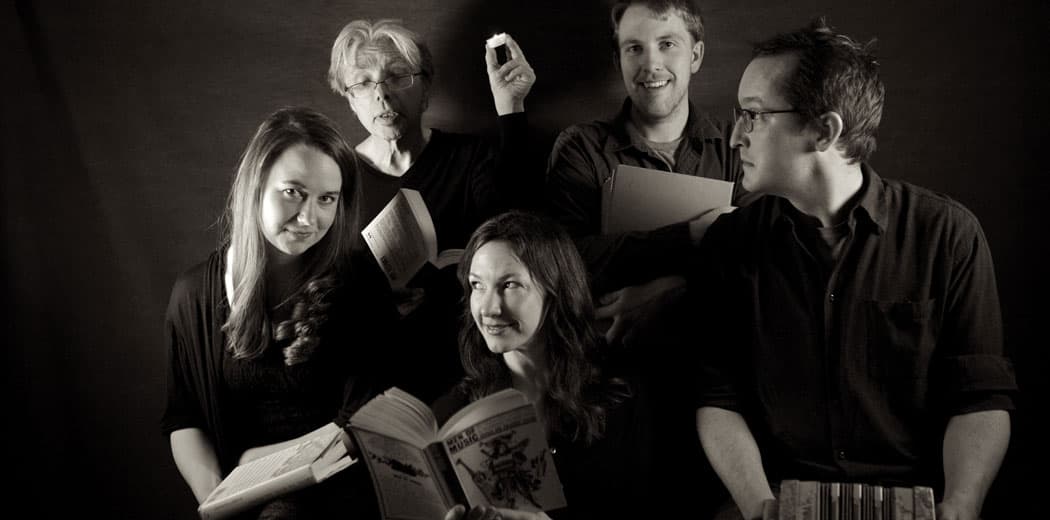Advertisement
Preview Darol Anger’s Rule-Breaking Bluegrass Album. Call It Meta-Grass.

Darol Anger has never sounded like other fiddlers. He has a voluptuous tone, round and warm and bold, almost electric. His solos are marked by a loopy wizardry, his tastes wide-ranging and restless.
“I was always really bad at imitating people,” says Anger (pictured at top left), who has gained renown over his 40-year career as an innovator of progressive bluegrass, for his work with mandolin master David Grisman and the famed jazz chamber group Turtle Island String Quartet, and for pioneering the wildly popular fiddle “chop,” a percussive bowing technique.
Though he finds kinship with bluegrass greats like Vassar Clements and Stuart Duncan, Anger, a California native who now teaches at Boston’s Berklee College of Music, says that he has been inspired as much by saxophone and electric guitar. It’s no surprise, really. His fiddle playing contains very little twang, but rather rock n’ roll audacity and psychedelic freeness. He is never afraid to get weird; in fact, he can’t seem to help it.
It stands to reason, then, that his latest endeavor—“E-and’a,” an instrumental bluegrass record out March 18—does not fit the traditional bluegrass mold. The title, pronounced “ee-AND-uh,” is informal musician-speak for the subdivisions between beats: ONE (ee-and-uh), TWO (ee-and-uh), THREE (ee-and-uh), FOUR. It’s a hallmark of bluegrass, which is grounded in a deep bass downbeat and accelerated by the chatty peregrinations of melody instruments like mandolin, banjo, and fiddle.
But the title’s peculiar punctuation is all Anger’s own. That is how “E-and’a” sounds, too: it falls within prescribed bluegrass boundaries, but what happens in between is just a little bit skewed from the norm.
For “E-and’a,” the 60-year-old Anger hired one (relative) industry veteran—Sharon Gilchrist, formerly of the Peter Rowan and Tony Rice Quartet, on double bass—and three up-and-coming hotshots: mandolinist Joe Walsh, an instructor at Berklee College of Music, who co-produced the album with Anger, and recent Berklee grads Lukas Pool, a two-time National Old-Time Banjo Champion, and guitarist Courtney Hartman, of the Grammy-nominated bluegrass band Della Mae.
“I’m gonna choose people that can play bluegrass, but are capable of thinking beyond the category. Sort of meta-grass,” Anger explains. “I want it to sound like music, I want it to sound like something happened. It’s not a re-enactment. We’re not fighting a battle where we know the outcome. We want it to be a new story, even though it’s in the style of bluegrass.”
What he means by the “style of bluegrass” is simply that the band plays ordinary fiddle tunes and everyone takes turns soloing, conventions established in the genre’s beginnings. “E-and’a” contains a mix of standard repertoire, contemporary covers, and originals—no experimental fusion or Swedish folk tunes, which Anger has shown a penchant for in the past. But where bluegrass cranks like a red-hot engine, “E-and’a” dances with elegant fluidity.
Though everyone in the group possesses a stunning level of technical skill, “E-and’a” does not smack of showiness. The true virtuosity is found in the musicians’ ability to play off of one another with both boundless inventiveness and intricate precision.
They shine in moments like the ones that conclude “Farewell to Trion,” an old-time fiddle tune popular for its built-in dynamics and sweet temperament. As they enter the final few bars, Anger launches into a canon-esque variation, circling mandolin and banjo like a melodic echo, while bass and guitar introduce a substitute chord progression that brings lift, and just a touch of yearning, to the arrangement. It is emotional but not overwrought, a fitting tribute to the endless possibilities found within even the simplest melodies, and the easy joy of playing a favorite tune over and over.